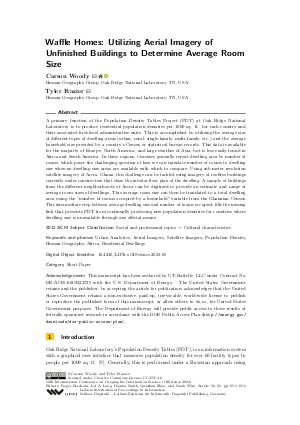Waffle Homes: Utilizing Aerial Imagery of Unfinished Buildings to Determine Average Room Size (Short Paper)
Authors
Carson Woody  ,
Tyler Frazier
,
Tyler Frazier
-
Part of:
Volume:
12th International Conference on Geographic Information Science (GIScience 2023)
Part of: Series: Leibniz International Proceedings in Informatics (LIPIcs)
Part of: Conference: International Conference on Geographic Information Science (GIScience) - License:
 Creative Commons Attribution 4.0 International license
Creative Commons Attribution 4.0 International license
- Publication Date: 2023-09-07
File

PDF
LIPIcs.GIScience.2023.85.pdf
- Filesize: 0.57 MB
- 6 pages
Document Identifiers
Subject Classification
ACM Subject Classification
- Social and professional topics → Cultural characteristics
Keywords
- Urban Analytics
- Aerial Imagery
- Satellite Imagery
- Population Density
- Human Geography
- Africa
- Residential Dwellings
Metrics
- Access Statistics
-
Total Accesses (updated on a weekly basis)
0Document
0Metadata
Abstract
A primary function of the Population Density Tables Project (PDT) at Oak Ridge National Laboratory is to produce residential population densities per 1000 sq. ft. for each country and their associated first-level administrative units. This is accomplished by utilizing the average size of different types of dwelling areas (urban, rural, single-family, multi-family, etc.) and the average household size provided by a country’s Census or statistical bureau records. This data is available for the majority of Europe, North America, and large swathes of Asia, but is less easily found in Africa and South America. In these regions, Censuses generally report dwelling area by number of rooms, which poses the challenging question of how we can translate number of rooms to dwelling size when no dwelling size areas are available with which to compare. Using sub-meter resolution satellite imagery of Accra, Ghana, this challenge can be tackled using imagery of roofless buildings currently under construction that show the interior floor plan of the dwelling. A sample of buildings from the different neighborhoods of Accra can be digitized to provide an estimate and range of average room sizes of dwellings. This average room size can then be translated to a total dwelling area using the "number of rooms occupied by a household" variable from the Ghanaian Census. This intermediate step between average dwelling size and number of rooms occupied, fills the missing link that prevents PDT from continually producing new population densities for countries where dwelling size is unavailable through any official means.
Cite As Get BibTex
Carson Woody and Tyler Frazier. Waffle Homes: Utilizing Aerial Imagery of Unfinished Buildings to Determine Average Room Size (Short Paper). In 12th International Conference on Geographic Information Science (GIScience 2023). Leibniz International Proceedings in Informatics (LIPIcs), Volume 277, pp. 85:1-85:6, Schloss Dagstuhl – Leibniz-Zentrum für Informatik (2023)
https://doi.org/10.4230/LIPIcs.GIScience.2023.85
BibTex
@InProceedings{woody_et_al:LIPIcs.GIScience.2023.85,
author = {Woody, Carson and Frazier, Tyler},
title = {{Waffle Homes: Utilizing Aerial Imagery of Unfinished Buildings to Determine Average Room Size}},
booktitle = {12th International Conference on Geographic Information Science (GIScience 2023)},
pages = {85:1--85:6},
series = {Leibniz International Proceedings in Informatics (LIPIcs)},
ISBN = {978-3-95977-288-4},
ISSN = {1868-8969},
year = {2023},
volume = {277},
editor = {Beecham, Roger and Long, Jed A. and Smith, Dianna and Zhao, Qunshan and Wise, Sarah},
publisher = {Schloss Dagstuhl -- Leibniz-Zentrum f{\"u}r Informatik},
address = {Dagstuhl, Germany},
URL = {https://drops.dagstuhl.de/entities/document/10.4230/LIPIcs.GIScience.2023.85},
URN = {urn:nbn:de:0030-drops-189804},
doi = {10.4230/LIPIcs.GIScience.2023.85},
annote = {Keywords: Urban Analytics, Aerial Imagery, Satellite Imagery, Population Density, Human Geography, Africa, Residential Dwellings}
}
Author Details
Acknowledgements
This manuscript has been authored by UT-Battelle, LLC under Contract No. DE-AC05-00OR22725 with the U.S. Department of Energy. The United States Government retains and the publisher, by accepting the article for publication, acknowledges that the United States Government retains a non-exclusive, paid-up, irrevocable, world-wide license to publish or reproduce the published form of this manuscript, or allow others to do so, for United States Government purposes. The Department of Energy will provide public access to these results of federally sponsored research in accordance with the DOE Public Access Plan (http://energy.gov/downloads/doe-public-access-plan).
References
-
Lewis Abedi Asante, Emmanuel Kofi Gavu, Jonathan Zinzi Ayitey, and Alexander Sasu. The changing face of compound houses in ghana and its effect on rental value: A case study of selected neighborhoods in kumasi, ghana. Technical report, African Real Estate Society (AfRES), 2015.

- Samantha Duchscherer, Robert Stewart, and Marie Urban. revengc: An R package to Reverse Engineer Summarized Data. The R Journal, 10(2):114-123, 2018. URL: https://doi.org/10.32614/RJ-2018-044.
- Yinka Ibukun. How city life transformed ghana’s compound houses. Bloomberg: CityLab, 2021. URL: https://www.bloomberg.com/news/features/2021-05-06/the-design-history-of-ghana-s-compound-houses.
- Google Maps Imagery. Accra google maps imagery, 2023. Imagery @2023 Google, Imagery @2023 CNES / Airbus, Maxar Technologies, Map data @ 2023. URL: https://www.google.com/maps/place/Accra,+Ghana/@5.6250365,-0.1023598,198m/data=!3m1!1e3!4m6!3m5!1s0xfdf9084b2b7a773:0xbed14ed8650e2dd3!8m2!3d5.6037168!4d-0.1869644!16zL20vMGZueWM.
-
Iman Khajehzadeh and Brenda Vale. Estimating the floor area of a house knowing its number of rooms and how these are named. In Back to the Future: The Next 50 Years, (51st International Conference of the Architectural Science Association (ANZAScA)), December 2017.

- Dahlia Nduom. Housing and culture in ghana: A model for research and evidence-based design. ARCC Conference Repository, September 2018. URL: https://www.arcc-repository.org/index.php/repository/article/view/533.
-
Ghana 2021 Population and Housing Census. Ghana 2021 population and housing census: Housing characteristics. Technical report, Ghana Statistical Service, 2021.

-
Ghana Statistical Service. Ghana living standards survey, report of the fifth round (glss 5). Technical report, Ghana Statistical Service, 2008.

- Robert Stewart, Marie Urban, Samantha Duchscherer, Jason Kaufman, April Morton, Gautam Thakur, Jesse Piburn, and Jessica Moehl. A bayesian machine learning model for estimating building occupancy from open source data. Natural Hazards, 2016. URL: https://doi.org/10.1007/s11069-016-2164-9.
- Marie Urban, Robert Stewart, Scott Basford, Zachary Palmer, and Jason Kaufman. Estimating building occupancy: a machine learning system for day, night, and episodic events. Natural Hazards, 2023. URL: https://link.springer.com/article/10.1007/s11069-022-05772-3#citeas.
